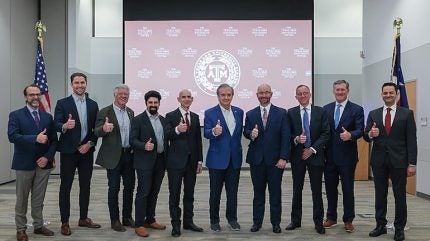
The Texas A&M University System has offered land near the university campus to four companies developing small modular reactors (SMRs) as construction sites. “Plain and simple: the United States needs more power,” said Chancellor John Sharp. “And nowhere in the country, other than Texas, is anyone willing to step up and build the power plants we need. Thanks to the leadership of Governor Greg Abbott and others in Texas state government, Texas A&M System stands ready to step up and do what is necessary for the country to thrive.”
CEOs from Kairos Power, Natura Resources, Terrestrial Energy and Aalo Atomics have agreed to work with the System to bring reactors to Texas A&M-RELLIS, a 2,400-acre technology and innovation campus in Bryan as part of The Energy Proving Ground project. The companies will work toward bringing commercial-ready technologies to the System land and using the project to test the latest prototypes.
According to Texas A&M, the first reactors could be constructed within five years. “Once it is completed, power generated at the proving ground could supply power to the Electric Reliability Council of Texas (ERCOT).”
Texas A&M System officials have streamlined the regulatory process to allow the four companies to quickly get their reactors operational. The System has started the application process with the US Nuclear Regulatory Commission (NRC) for an Early Site Permit. The application will be for the potential development of commercial electrical and thermal power generation facilities. The proposed site is projected to accommodate multiple SMRs with a combined electrical output of more than one gigawatt.
This project is part of the Texas A&M System’s broader commitment to advancing nuclear research, education and energy production. Joe Elabd, Vice Chancellor for Research at the Texas A&M System, said the Energy Proving Ground will have an extraordinary effect on the future of energy delivery in the US.
“The agreements that the Texas A&M System has with Kairos, Natura, Terrestrial and Aalo are going to change the energy landscape for the whole country,” he added. “The Energy Proving Ground will allow these companies to safely test their SMRs and set the stage for deploying small nuclear reactors across the country.”
Mike Laufer, co-founder and CEO of Kairos Power expects to bring one or more commercial deployments to the site based on the fluoride salt-cooled high-temperature reactor (KP-FHR) currently under development. In 2023, NRC issued a construction permit for Kairos Power’s Hermes demonstration reactor – the first non-water-cooled reactor to be approved for construction in the US in more than 50 years.
Douglass Robison, the founder and CEO of Natura Resources, said that the Texas A&M System has been an integral partner over the past five years, collaborating with the company to develop the Natura MSR-1 demonstration system. Natura Resources is developing liquid-fuelled molten salt reactor technology. “We are thrilled to continue this partnership … to deploy our commercial system, the Natura MSR-100, on the Texas A&M-RELLIS campus.” In September 2024, the company received the first NRC construction permit for its MSR-1 research reactor at Abilene Christian University (ACU) in Texas. Natura is targeting 2030 for its 100 MWe commercial unit deployment.
Simon Irish, CEO of Terrestrial Energy, said he hoped to develop the Integral Molten Salt Reactor (IMSR), technology at the site in Bryan. “Siting an IMSR plant at the RELLIS campus leverages Texas A&M’s world-class research and nuclear engineering capabilities; provides a source of clean, firm electricity for the local grid (ERCOT); and positions Texas as a leader in America’s nuclear technology sector.”
Matt Loszak, co-founder and CEO, Aalo Atomics, said his company could build up to six Aalo Pods at the site. “This collaboration is a pivotal step for Aalo as it provides us with a platform to demonstrate the potential of our factory mass-manufactured nuclear technology to deliver reliable, clean energy that will ultimately power the next generation of data centres and AI infrastructure.,” he said. Aalo is developing a factory-built 10-MWe thermal neutron spectrum, sodium-cooled microreactor using uranium zirconium hydride fuel for inherent safety based on Idaho National Laboratory’s MARVEL project. Aalo aims to develop a 30 MWt sodium-cooled microreactor within the next few years.
The Texas A&M University System is one of the largest systems of higher education in the US, with a budget of $7.3bn. The Texas A&M System, through a statewide network of 11 universities, a comprehensive health science centre, eight state agencies, Texas A&M-Fort Worth and Texas A&M-RELLIS, educates more than 157,000 students and makes more than 21m additional educational contacts through service and outreach programmes each year.
Texas A&M is also part of NEXTRA – the NEXT Research Alliance – led by ACU. Other members of the consortium are Georgia Institute of Technology and The University of Texas at Austin Launched in Spring 2019, the consortium’s goal is to design, license and commission the first university-based molten salt research reactor, which ACU will host and own.






